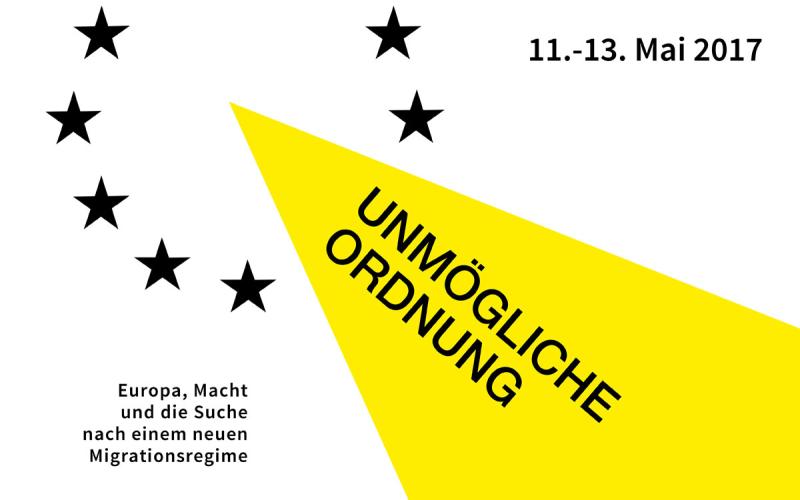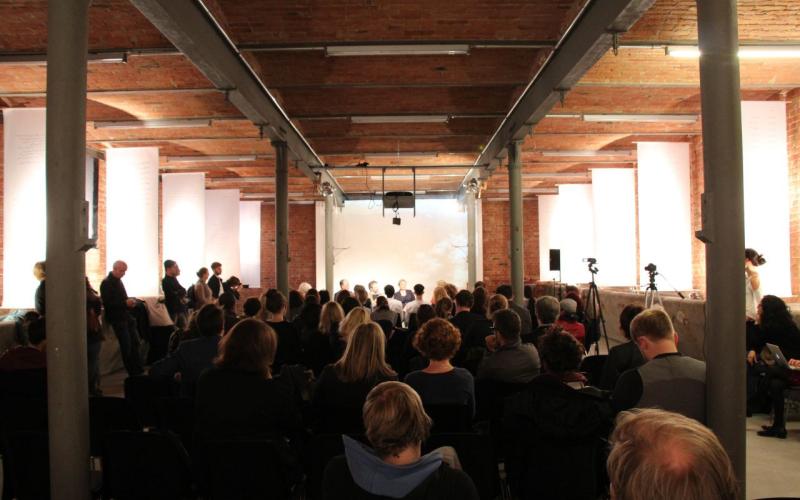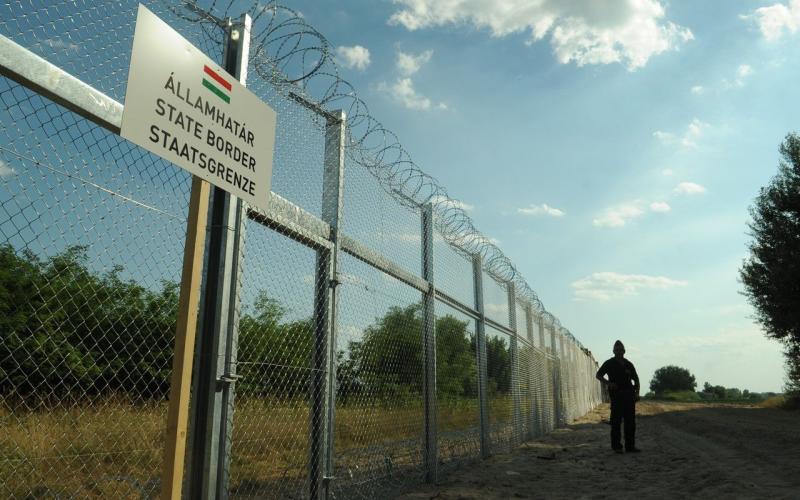After an inspiring tour through the Berlin Wall Memorial, the conference lead to another highlight: a short performance of the play “Eyes under the Sea”, written by the academic artist / artistic academic Yiannis Lymtsioulis and staged by Anton Juan, a director and theater professor at the University of Notre Dame, IN. Before the play started Lymtsioulis introduced the audience to the process behind this short piece and the importance of bringing it to the Berlin Wall Memorial: already three years ago he attended another conference in Berlin. Like today, the discussions centered (among other things) around the drowning of thousands of people in the Mediterranean sea trying to escape from war and hopelessness. Back in Madrid he decided to write about it. Thus he returned to one of his older plays on this very topic. Inspired by “Guernica”, one of the most famous works of art of Pablo Picasso, he brings the chaotic and desperate struggle for life and the consequences of the EU migration regime under the sea to light.
Although the sequence from only took a few minutes, it was definitely one of the most inspiring and emotional moments in the conference. It enriched the perspective on “flight” – not so much by creating new concepts or by bringing up new questions but rather by zooming in onto the happing. The fragment of the play the actors Luis Lopez-Maldonado (University of Notre Dame, USA) and Missy Maramara (Centre Les Récollets, Paris) presented to us showed an refugee woman of drowned but not yet deceased after the sinking of the Albanian refugee ship in the Mediterranean sea after an alleged accident with an Italian military vessel. Like the big foot of the fleeing woman in Picasso's “Guernica” suggests, here the woman too still desires to return to life, to her family.
Here in Berlin nothing could have better accentuated the the fusion between past and than the location: The actors literally wrapped themselves around the Berlin Wall, reviving it, bringing the “far away” borderlands to the here and now – what is very tragic as the Mauer was torn down with so much power, enthusiasm and hope.
The play began with a staggered man with ragged grimy clothes and a rainstick in his hands – shaking and sounding like the sea. A woman awakes, she cries painfully and is reaching for the man again and again, making surreal torsions. A blue fabric is pulled around her, and with every movement she is finding herself tangled up more and more in it.
The women's words were those of a victim of a crime, a woman in shock, who cannot believe what just has happened. In contrast, the text of the “sea” was that of an old witness. She asked: “How can they sleep?” He answered: “Their eyes are just closed, pretending to sleep” [1]. She said half stating half questioning: “It is all just a joke? It is just a big dream. They didn´t drowned us intentionally.“[2] --- „Not every day is an accident”, he answered.
The play ends dramatically: just as it seemed that the woman survives, phoning with somebody from her family, asking about her children, telling that she will be back soon, the “sea” grapped her and silenced her suffocating.
—Now, who is the murderer? The sea – both beautiful like an angel and fatal like satan? The people who turned the sea into a murderer? The pretending dreamers who missed their roles as witnesses? Are we scared to open the eyes under the sea as it will hurt, scared of the sight it will give us? Was it murder or was it accident? It is a grey zone that, starting in Guernica in 1937, turned civilians into the main victims of war? Or were they simply the targets? Or was the only target to secure the own ideology and to frighten the “others” from violating the (b)orders? These questions could not be answered with a mere “Yes” or “No”. But still, who can be held responsible for the death of people longing for a better future?
Here at the former Berlin Wall, these unintentional “not-accidents” can be compared with the “accidents” that we got to know in the guide through the memorial before: when children of the east side of Berlin felt into the river and people from the west side could not help because they themselves were afraid of getting shot by the border guards. Still, despite the decrease of outrage about our own times, the number of those “unintentionally killed” today is much higher.
The play tore me under water and forced me to put myself in the place of the drowning woman - what I always have defended normally in front of the TV. I always thought “hopefully they get unconscious right away, that they don´t have to suffer”. However in thinking this I made myself unconscious of the victims struggle for life and their final thoughts under the sea. In fact, “eyes under the sea” forced me to look more closely, to explore “escape” not just in theories from my desk but in situ, by at least trying to putting myself into the shoes of refugees. I think this is what was also clearly audible in the atmosphere of the audience: to realize that we have to overcome the egocentric distance and to allow and face the interconnections through us in space and time. To fight together, to make the sea again a place of open disorder and not that as of a (b)order, the location of the memorial spreads a gleam of hope for this way.
Zitation
Stefanie Hamm, “Eyes under the Sea“ at the Memorial “Berliner Mauer”. Theater Performance , in: Zeitgeschichte-online, , URL: https://zeitgeschichte-online.de/themen/eyes-under-sea-memorial-berliner-mauer



